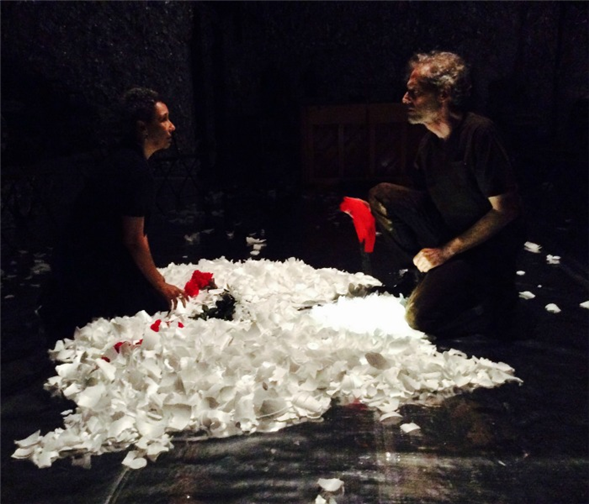Translate Page

Amina Henry uses her true-crime obsession to make a bold statement in Hunter John and Jane
---
Amina Henry is really into true-crime shows. She loves the way they suck her in and unsettle her mind. But while Hunter John and Jane was inspired by her affinity for the genre, it subverts the familiar formula. Currently running at JACK in Brooklyn, Henry's play imagines a world of alternate possibilities, where whimsy lurks at the edges of violence against women, and people who are lost really can be found.
"I find shows like Disappeared: Gone in an Instant and Dateline super-absorbing and haunting," says Henry. "Most of the time the victims are white and I have often thought, wow, that's super-interesting and frustrating. Why is that?"
Henry, who is black, took that question and applied it to Hunter John and Jane, in which Mother (Madeline McCray), who is African-American, searches tirelessly for her daughter Jane, a missing prostitute. Although Jane has been murdered, her ghost (Erin Cherry) haunts the park where she died. In this metaphysical reality, she is able to strike up a friendship with Hunter John (Bob Jaffe), a homeless man, who ultimately helps the family find peace.
The narrative fuses Henry's fertile imagination with aspects of two real-life stories that captivated her. The first came from an episode of Disappeared that chronicled a mother's quest to locate her daughter, a sex worker who vanished on Long Island. While looking for her, authorities discovered the bodies of several other women. "They had stumbled on a serial killer's burial ground," Henry recalls. "A few of those victims had not even been reported as missing." The dramatist was struck by the mother saying she wanted her daughter's life -- or, more accurately, her death -- to have meaning because all those other people were found.
The other tale that fascinated Henry was the documentary Dreams of a Life about Joyce Vincent, a 38-year-old black Londoner who died on her couch and wasn't discovered for more than two years. "It shows all these people that knew Joyce during her life saying things like, 'We thought she was on an adventure somewhere,'" Henry says. "It scared me that someone could live a life and have friends and a family, but no one would look for her for that long. To be that isolated really freaked me out. Everyone deserves to have someone look for them."
Henry mitigates the heavy nature of Hunter John and Jane by weaving in lighter elements. "We have a live guitarist who plays throughout the transitions," she says. "I wanted to create a different texture. Jane's character has a kind of R&B feel, Mother's music is more bluesy and jazzy, and Hunter John has an American folk sound. This story is horrifying, yet the music is so delightful."
The puppetry is, too. Originally, Henry envisioned a character named Boy with Kite, "but we couldn't afford a real child," she says, laughing. "So we made him Boy with Balloon and he's a puppet. It gives him a real magical quality."
Henry acknowledges that in real life, people who vanish -- especially those of color -- are often never found. But it was important to her that the family at the center of Hunter John and Jane got closure. "So often in these crime shows people will say things like, 'She was a good girl,' implying that if you weren't a good girl or were living a high-risk life, then somehow you deserved to die," she says. "I wanted to create a space for women of color and prostitutes and people on the outer edges of society where they were given the dignity of being looked for."
---
Eliza Bent is a playwright, performer, and sometime pundit. Follow her on Instagram at @getbentobox. Follow TDF on Instagram at @officialtdf.
Top image: Madeline McCray and Bob Jaffe in Hunter John and Jane. Photo courtesy of Amina Henry.
TDF MEMBERS: Go here to browse our latest discounts for dance, theatre and concerts.